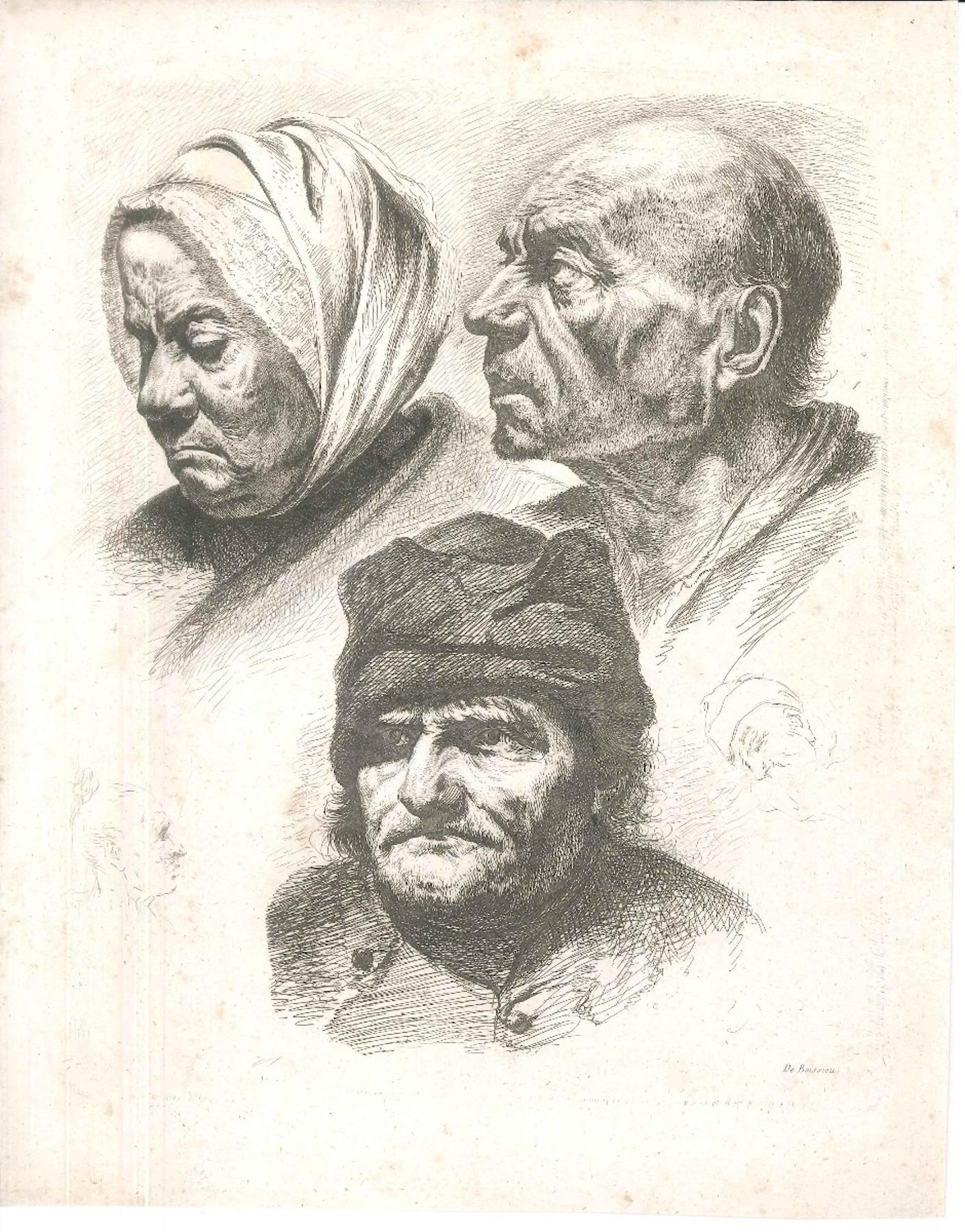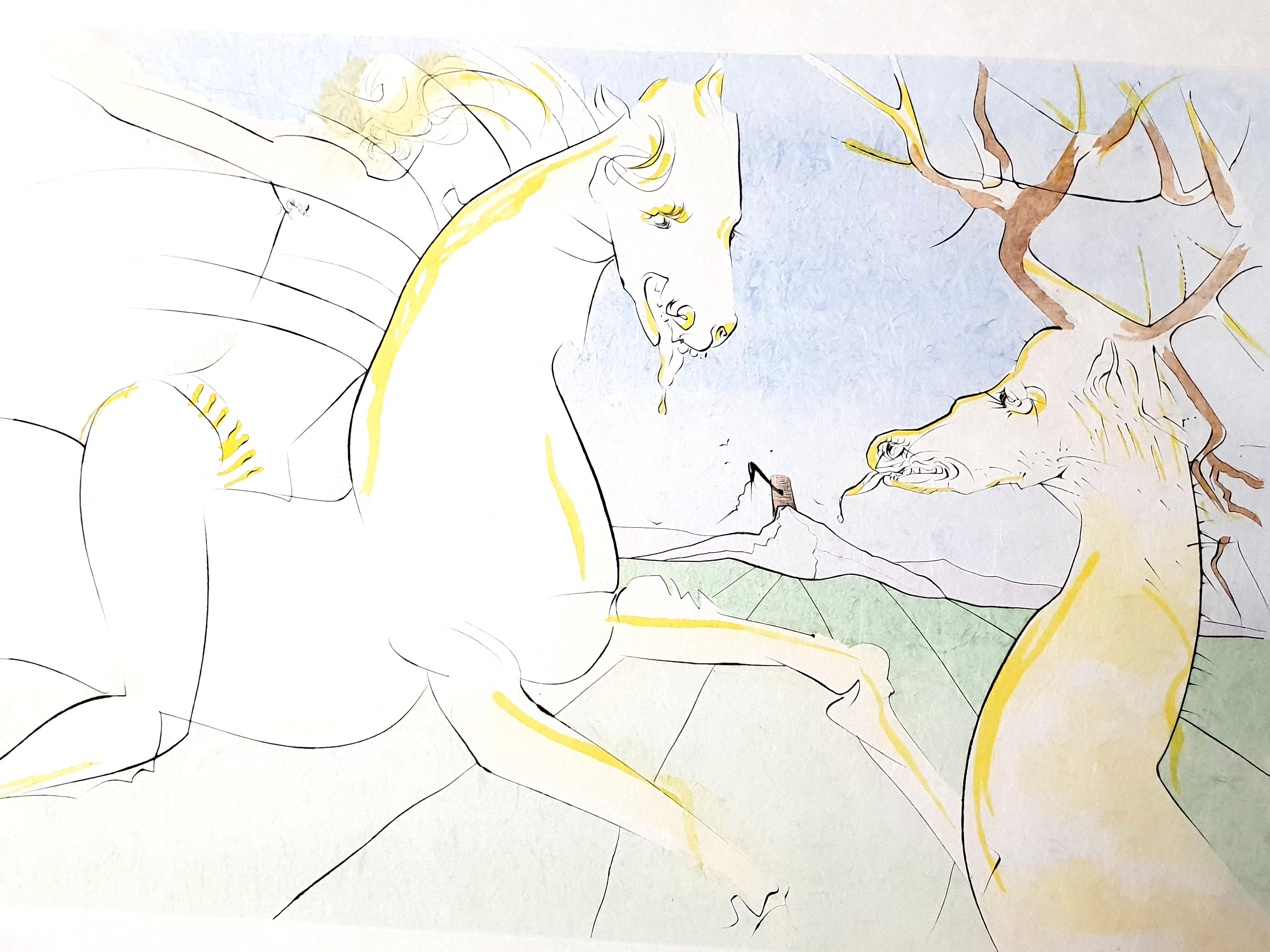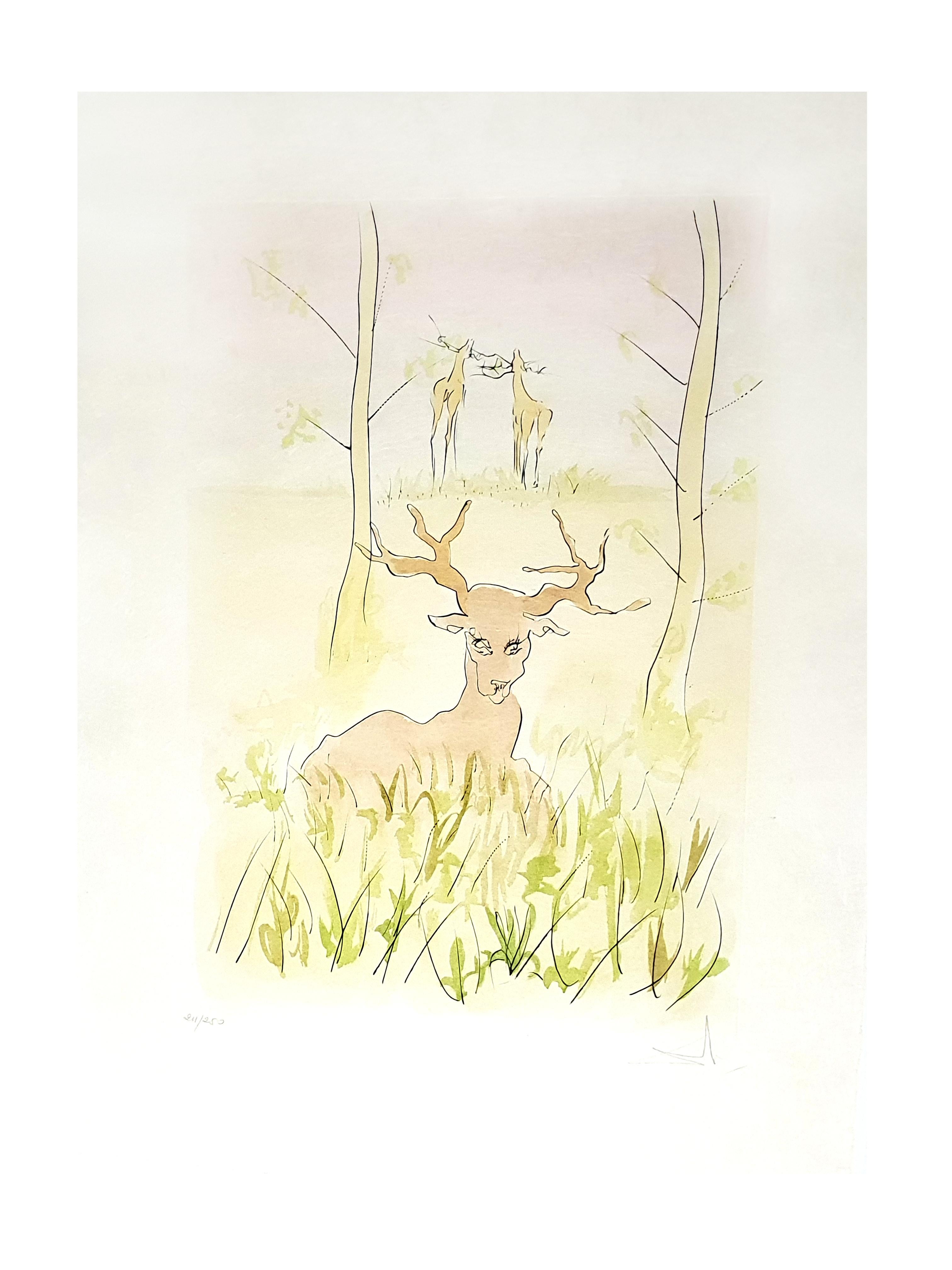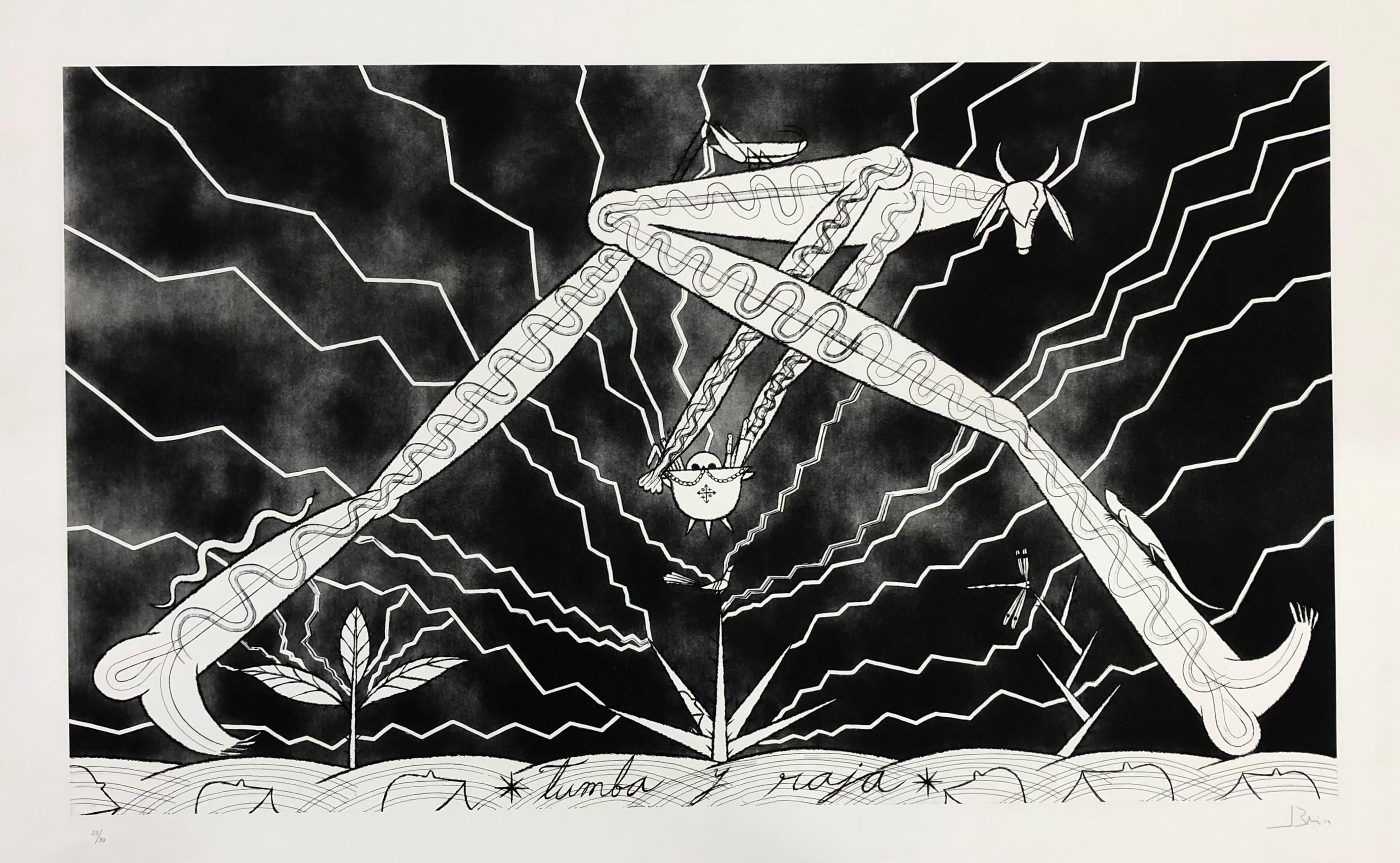Items Similar to "Nohubo remedio" (There was no remedy) - Etching and Aquatint on Paper
Want more images or videos?
Request additional images or videos from the seller
1 of 15
Francisco Goya"Nohubo remedio" (There was no remedy) - Etching and Aquatint on Paper1799
1799
About the Item
"Nohubo remedio" (There was no remedy) - Etching and Aquatint on Paper
Bold 3rd or 4th edition, circa 1868-1878, with burnished aquatints, drypoints etching, and engravings by Franciso de Goya (Spanish, 1746-1828). Fine impression in dark umber ink on wove paper. A woman is dressed in a tall pointed cap, with her arms and neck bound in some kind of restraint, riding a donkey through a crowd. The people in the crowd bear sinister and grimaced expressions. Behind the captured woman, two officials in ornate hats and wigs ride horses and hold whips. Titled "Nohubo remedio" at the bottom, meaning "there was no remedy" or "nothing could be done about it." Numbered "24" in the upper right corner, just inside the plate. This piece is a critique of the Inquisition - this victim had no chance for justice as they were swept up in the superstition and ignorance of the times.
The third edition was made by the Calcografia Nacional as well, and the complete set is made up of 80 original etchings with burnished aquatints, drypoints, and engravings on woven paper, and was published in 1868. This edition is very well-printed on a strong absorbent paper that is similar to that of the second edition. All the sheets are numbered on the upper part and titled on the lower central margin. The sheets are bound along the left edge, in yellow pasteboard covers on which 'Caprichos de Goya-Coleccion de ochenta estampas grabadas al agua fuerte con aguadas de resina por el mismo' is printed. The sheets measure 310 x 230 mm; a dark umber ink was used for the whole series.
The fourth edition is a very limited edition of prints, only 65, published in 1878 ca. by the Calcografia Nacional. This edition again presents the same paper, ink, and cover as those of the third edition.
"GOYA 43358 (37)" is written in pencil on verso.
Tag on verso from previous owner.
Presented in an ornate gilded frame with a linen liner.
Frame size: 22.5"H x 20.5"W
Plate size: (213 x 150)
Sheet 11 94" x 8.75 (302 x 221)
- Creator:Francisco Goya (1746 - 1928, Spanish)
- Creation Year:1799
- Dimensions:Height: 22.5 in (57.15 cm)Width: 20.5 in (52.07 cm)Depth: 1.5 in (3.81 cm)
- Medium:
- Movement & Style:
- Period:1790-1799
- Condition:Very good condition for it's age. Very mild tonal ageing from a previous mat, but not visible unless removed from frame and mat.
- Gallery Location:Soquel, CA
- Reference Number:
About the Seller
5.0
Platinum Seller
These expertly vetted sellers are 1stDibs' most experienced sellers and are rated highest by our customers.
Established in 1986
1stDibs seller since 2014
2,515 sales on 1stDibs
Typical response time: <1 hour
- ShippingRetrieving quote...Ships From: Soquel, CA
- Return PolicyA return for this item may be initiated within 14 days of delivery.
More From This SellerView All
- Art Deco Etching and Aquatint "Jeunesse" Original Signed by Louis IcartBy Louis IcartLocated in Soquel, CAArt Deco Etching and Aquatint "Jeunesse" (Youth) Signed by Louis Icart Iconic figurative of woman and horse titled "Jeunesse" (Youth) by famous Art Deco artist Louis Icart (French, ...Category
1930s Art Deco Figurative Prints
MaterialsPaper, Pencil, Aquatint
- 1970's Figurative Home Interior Etching, Portrait of a Couple with DogsLocated in Soquel, CA1970's modernist etching of a man and woman at home with their dogs by Stephen Martin (American, 20th Century). The enigmatic couple both wear sungla...Category
1970s Contemporary Figurative Prints
MaterialsPaper, Ink, Etching
- Conversations at the Bar - Figurative Animal EtchingLocated in Soquel, CA1970's modernist anthropomorphic animals at a bar by Stephen Martin (American, 20th Century). Several animals sit at a bar, with a few in the b...Category
1970s Contemporary Figurative Prints
MaterialsPaper, Ink, Etching
- "Horses", 1960's Pop Art Etching A/PBy Marc Foster GrantLocated in Soquel, CAA late 1960's modern Pop Art etching of horses by Marc Foster Grant (American, b.1947). The galloping horse motif is repeated, in the style of Warhol...Category
1960s Pop Art Animal Prints
MaterialsPrinter's Ink, Etching, Paper
- Panther - Figurative Abstract Woodcut, 3/10By Cecelia Sánchez DuarteLocated in Soquel, CAFigurative abstract wood cut print titled "Copula Blanca" by Cecelia Sánchez Duarte. Pencil signed with edition number "3/10," title, and signature bottom margin. Image, 31.25"H x 23...Category
1990s Folk Art Figurative Prints
MaterialsArchival Paper, Woodcut
- "The hen that lays is the hen that pays" Screenprint on PaperLocated in Soquel, CA"The hen that lays in the hen that pays" Screenprint on Paper Bold screenprint by Toni Carner (American, b. 1957). A large, patterned hen is sitting on th...Category
1970s Minimalist Figurative Prints
MaterialsInk, Screen, Paper
You May Also Like
- Study of Six Heads - Etching by J.-J. BoissieuBy Jean-Jacques de BoissieuLocated in Roma, ITStudy of Six Heads is a beautiful black and white etching with drypoint interventions on paper, realized at the end of XVIII century by the French artist Jean-Jacques de Boissieu (Lyon, 1736- 1810). Six study od heads ( four elder men, a middle-aged man at the center, and a woman with turbant) etched with a superb technique and an incredible draftsmanship are drawn to different scales and with different degrees of finish, have the dignity of six different portraits with the same passion and effort. Signed on plate on lower right margin “De Boissieu”. Inscription ( number plate) on higher-right corner "10". This old master’s original print with lifetime impressions, is in very good conditions, except for a usual yellowing of the paper above all on the edges and some signs of the time,do not affect the image. Jean-Jacques de Boissieu (Lyon,1736 –1810) Jean-Jacques de Boissieu was a French artist studied at the École de Dessin in Lyon, but he was mostly self-taught. His first prints were realized between 1758–64. When he went to Italy in the retinue of the ambassador and Duc de la Rochefoucauld d’Enville, he had the lifechanging encounter: he met Voltaire and he entered in the world of luminaries, he had the opportunity of realizing some plates for the Diderot-d’Alembert’s Encyclopèdie. Then he continued to produce prints in Lyon, Boissieu made many etchings of the Roman and Dutch countryside, as well as the French countryside around Lyon, which earned him a reputation as the last representative of the older etching...Category
Late 18th Century Old Masters Animal Prints
MaterialsEtching, Drypoint
- Study of Five Heads - Original Etching by J.-J. BoissieuBy Jean-Jacques de BoissieuLocated in Roma, ITStudy of Five Heads is a beautiful black and white etching with drypoint interventions on paper, realized at the end of XVIII century by the French artist Jean-Jacques de Boissieu (Lyon, 1736- 1810). Five study of heads of which two profiles (a female and a male) are lightly sketched with the drypoint technique, and we could appreciate the incredible draftsmanship. Instead, the bigger three portraits are very detailed and etched with a superb technique. Although the subjects are drawn in different scales and with different degrees of finish, each portrait has the dignity of a unique piece and the composition is very balanced. In particular on the lower margin at the center there is the portrait of "Le Père Cotrot, Garçon Teinturier à Lyon'", an elderly man, toothless and with a large-nosed, slightly turned to left, with a hat and unbuttoned jacket over waistcoat, shows all his wrinkles in a very realistic way. Signed on plate on lower right margin “De Boissieu”. This old master’s original print with fresh impressions, is in very good conditions, except for a usual yellowing of the paper above all on the edges and some signs of the time and light foxing along the margins, do not affect the image. Jean-Jacques de Boissieu (Lyon,1736 –1810) Jean-Jacques de Boissieu was a French artist studied at the École de Dessin in Lyon, but he was mostly self-taught. His first prints were realized between 1758–64. When he went to Italy in the retinue of the ambassador and Duc de la Rochefoucauld d’Enville, he had the lifechanging encounter: he met Voltaire and he entered in the world of luminaries, he had the opportunity of realizing some plates for the Diderot-d’Alembert’s Encyclopèdie. Then he continued to produce prints in Lyon, Boissieu made many etchings of the Roman and Dutch countryside, as well as the French countryside around Lyon, which earned him a reputation as the last representative of the older etching...Category
Late 18th Century Old Masters Animal Prints
MaterialsDrypoint, Etching
- PEINTRE AU TRAVAIL (BLOCH 1157)By Pablo PicassoLocated in Aventura, FLEtching, aquatint, drypoint and scraper, on Rives BFK paper. Hand signed and numbered by Pablo Picasso. Published by Galerie Louise Leiris, Paris. Image size 12.125 x 18.125 inches. ...Category
1930s Cubist Animal Prints
MaterialsDrypoint, Paper, Aquatint, Engraving
- "Tumba y Raja", 2019, signed limited edition original art print engravingBy Jose BediaLocated in Miami, FLJose Bedia (Cuban, 1959) 'Tumba y Raja', 2019 Sugarlift on iron plate Limited edition of 30 Image size: 89.5 x 151.5 cm. (35.2 x 59.6 in.) Overall size: 109 x 172 cm. (42.9 x 67.7 in...Category
2010s Contemporary Animal Prints
MaterialsMetal, Iron
- Salvador Dali - Le Cerf from Le Bestiaire de la Fontaine - Signed EngravingBy Salvador DalíLocated in Collonge Bellerive, Geneve, CHSALVADOR DALI Le Cerf Malade from Le Bestiaire de la Fontaine 1974 Hand signed by Dali Edition: /250 The dimensions of the image are 22.8 x 15.7 inches on 31 x 23.2 inch paper Refer...Category
1970s Surrealist Figurative Prints
MaterialsDrypoint, Aquatint
- Salvador Dali - The Oak and the Reed - Signed EngravingBy Salvador DalíLocated in Collonge Bellerive, Geneve, CHSALVADOR DALI The Oak and the Reed (La chêne et le roseau) from Le Bestiaire de la Fontaine 1974 Hand signed by Dali Edition: /250 Conditions: A small tear defect has been restaured...Category
1970s Surrealist Figurative Prints
MaterialsDrypoint, Aquatint




